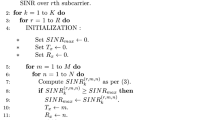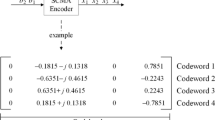Abstract
In this paper, we discuss different algorithms that can be used to encode channel state information (CSI) in realistic multi-user multiple-input multiple-output (MIMO) systems where there are only few users experiencing similar propagation conditions and the mobile user receivers do not necessarily have the same number of receive antennas. We divide systems with CSI encoding into four classes: time-division multiplexing (TDM) with and without linear pre-coding, and multiple user scheduling with and without linear pre-coding. The practical aspects such as system’s complexity and approaches for transmitting the CSI feedback and rate information from the mobile receivers to the base station are discussed and compared for different bit rates in the feedback link. We show that significant increases of the mean throughput of the multi-user scheduling systems demand much higher feedback link bit rates than TDM solutions. We also demonstrate that, while optimum, the non-linear pre-coding systems may introduce unacceptable degree of complexity into the base station design while linear pre-coding offers a very good trade-off between performance and complexity.
Similar content being viewed by others
References
Paulraj, A., Gore, D., & Nabar, R. (2003). Introduction to space-time wireless communications. Cambridge University Press.
Costa M. (1978). Writing on dirty paper. IEEE Transactions on Information Theory 29: 439–441
Goldsmith A., Jafar S., Jindal N. and Vishwanath S. (2003). Capacity limits of MIMO channels. IEEE Journal on Selected Areas in Communications 21: 684–702
Love R., Heath R. and Strohmer T. (2003). Grassmanian beamforming for multiple-input multiple-output wireless systems. IEEE Transactions on Information Theory 49: 2735–2747
Lau V., Liu Y. and Chen T.-A. (2004). On the design of MIMO block-fading channels with feedback-link capacity constraint. IEEE Transactions on Communications 52: 62–70
Roh J. and Rhao B. (2004). Performance analysis of multiple antenna systems with VQ-based feedback. IEEE Transactions on Information Theory 51: 1978–1982
Mukkavilli K.K., Sabharwal A., Erkip E. and Aazhang A. (2003). On beamforming with finite rate feedback in multiple antenna systems. IEEE Transactions on Information Theory 49: 2562–2579
Blum, R. S. (2003). MIMO with limited feedback of channel state information. Paper presented at IEEE International Conference on Acoustics, Speech, and Signal Processing.
Jindal N. (2006). MIMO broadcast channels finite-rate feedback. IEEE Transactions on Information Theory 52: 5045–5060
Mielczarek, B., & Krzymień, W. A. (2006). Vector quantization of channel information in linear multi-user MIMO systems. Paper presented at IEEE International Symposium on Spread Spectrum Techniques and Applications, Manaus, Brasil.
Mielczarek, B., & Krzymień, W. A. (2007). Influence of CSI feedback delay on capacity of linear multi-user MIMO systems. Paper presented at Proceedings of the IEEE Wireless Communications and Networking Conference, Hong Kong.
Mielczarek, B., & Krzymień, W. A. (2007). Influence of CSI feedback errors on capacity of linear multi-user MIMO systems. Paper presented at Proceedings of the IEEE Vehicular Technology Conference, Dublin, Ireland.
Hochwald B.M., Marzetta T.L. and Tarokh V. (2004). Multi-antenna channel hardening and its implications for rate feedback and scheduling. IEEE Transactions on Information Theory 50: 1893–1909
Mazzarese, D., & Krzymień, W. A. (2003). High throughput downlink cellular packet data access with multiple antennas and multiuser diversity. Paper presented at Proceedings of the IEEE Vehicular Technology Conference, Jeju, Korea.
Telatar I.E. (1999). Capacity of multi-antenna Gaussian channels. European Transactions on Telecommunications (ETT) 10: 585–595
Aktas, D., & El Gamal, H. (2003). Multiuser scheduling for MIMO wireless systems. Paper presented at Proceedings of the IEEE Vehicular Technology Conference, Orlando, USA.
Mielczarek, B., & Krzymień, W. A. (2006). Throughput of heterogeneous multi-cell multi-user MIMO-OFDM systems. Presented at Proceedings of the 5th International Workshop on Multi-Carrier Spread Spectrum (MC-SS), Oberpfaffenhofen, Germany. Published as K. Fazel & S. Kaiser (Eds.). (2006). Multi-carrier spread-spectrum. Springer.
Spencer Q., Swindlehurst A. and Haardt M. (2004). Zero-forcing methods for downlink spatial multiplexing in multiuser MIMO channels. IEEE Transactions on Signal Processing 52: 461–471
Caire G. and Shamai S. (2003). On the achievable throughput of a multi antenna Gaussian broadcast channel. IEEE Transactions on Information Theory 49: 1691–1706
Mielczarek, B., & Krzymień, W. A. (2007). Quantization of channel state information in multiple antenna systems. US Patent 11/754, 965, 29 May 2007.
Fisher N.I., Lewis T. and Embleton B. (1987). Statistical analysis of spherical data. Cambridge University Press, UK
Author information
Authors and Affiliations
Corresponding author
Rights and permissions
About this article
Cite this article
Mielczarek, B., Krzymień, W.A. Comparison of Partial CSI Encoding Methods in Multi-User MIMO Systems. Wireless Pers Commun 52, 177–193 (2010). https://doi.org/10.1007/s11277-008-9504-3
Published:
Issue Date:
DOI: https://doi.org/10.1007/s11277-008-9504-3




